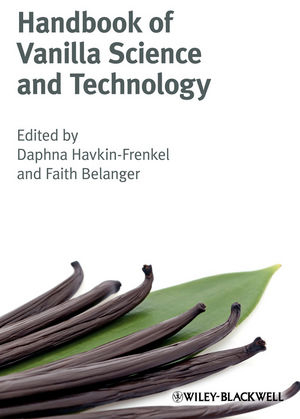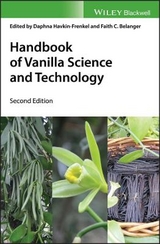
Handbook of Vanilla Science and Technology
Wiley-Blackwell (an imprint of John Wiley & Sons Ltd) (Verlag)
978-1-4051-9325-2 (ISBN)
- Titel erscheint in neuer Auflage
- Artikel merken
Vanilla is the world's most commonly-used flavour and fragrance, used in foods, cosmetics, pharmaceuticals and other products and is therefore of considerable economic importance. This book provides a comprehensive overview of the science and technology used in the production and supply chain of vanilla products. A wide range of international authors cover topics which include agricultural production, global markets, analytical methods, sensory analysis, food and fragrance applications, organic and fair trade vanilla, diseases that affect vanilla, and novel uses. It is of interest to academic researchers in this field and is also an important resource for the vanilla industry and those companies that use vanilla and vanillin as flavours and fragrances worldwide. Key Features: * The only book to cover such a wide range of topics on this most commercially valuable of flavour ingredients * Includes an analysis of the current vanilla markets in the US and Europe * Edited by experts who hold roles in the flavour industry and academic research
Dr Daphna Havkin-Frenkel , Biotechnology Center for Agriculture and the Environment, School of Environmental and Biological Sciences, Rutgers, The State University of New Jersey, New Brunswick, New Jersey, USA. Dr Faith C. Belanger , Plant Biology and Pathology Department and Biotechnology Center for Agriculture and the Environment, Rutgers, The State University of New Jersey, New Brunswick, New Jersey, USA.
Contributors. PRODUCTION OF VANILLA - AGRICULTURAL SYSTEMS AND CURING. 1 Mexican Vanilla Production (Juan Hernandez-Hernandez). 1.1 Introduction. 1.1.1 The Mexican Vanilla Legend. 1.2 Cultivation Methods. 1.2.1 "Traditional"/Acahual. 1.2.2 Intensive System (Monoculture). 1.2.3 Vanilla Cultivation in Existing Orange Groves. 1.2.4 Shade Houses. 1.3 Vanilla Propagation Techniques. 1.3.1 Preparation and Disinfection of Cuttings. 1.3.2 Establishing Cuttings - Timing. 1.3.3 Establishing Cuttings - Planting. 1.3.4 New Bud Formation and Root Growth. 1.4 Irrigation. 1.5 Nutrition. 1.5.1 Mulch. 1.5.2 Building Compost. 1.6 Weed Control. 1.7 Shade Management (Pruning of Support Trees). 1.8 Shoot Management - Looping. 1.9 Shoot Management - Rooting. 1.10 Main Vanilla Insect Pest. 1.11 Main Vanilla Diseases. 1.11.1 Anthracnose. 1.11.2 Rust. 1.11.3 Yellowing and Pre-Mature Fruit Drop. 1.12 Flowering and Pollination. 1.12.1 Percent of Flowering Plants. 1.12.2 Natural Pollination. 1.12.3 Hand Pollination. 1.12.4 Quantity of Flowers to be Pollinated. 1.12.5 Fruit Development. 1.13 Harvesting. 1.13.1 Harvesting Practices. 1.13.2 Preventing Theft. 1.14 Green Vanilla Commercialization. 1.14.1 Prices. 1.15 Curing. 1.15.1 Yield Ratio of Green/Cured Vanilla. 1.16 Grading. 1.16.1 Packing. 1.17 Buyers. 1.18 Export Volume. 1.19 Prices. 1.20 Aromatic Profile. 1.21 Summary. References. 2 Vanilla Diseases (Juan Hernandez-Hernandez). 2.1 Introduction. 2.2 Root and Stem Rot (Fusarium Oxysporum F. SP. Vanillae). 2.2.1 Description. 2.2.2 Damage. 2.2.3 Control. 2.3 Black Rot (Phytophtora SP.). 2.3.1 Description. 2.3.2 Damage. 2.3.3 Control. 2.4 Anthracnose (Colletotrichum SP.). 2.4.1 Description. 2.4.2 Damage. 2.4.3 Control. 2.5 Rust (Uromyces SP.). 2.5.1 Description. 2.5.2 Damage. 2.5.3 Control. 2.6 Rotting of Recently Planted Cuttings. 2.6.1 Description. 2.6.2 Damage. 2.6.3 Control. 2.7 Yellowing and Shedding of Young Fruits. 2.7.1 Description. 2.7.2 Damage. 2.7.3 Control. 2.8 Viral Diseases. 2.8.1 Cymbidium Mosaic Virus (CYMV). 2.8.2 Vanilla Mosaic Virus (VMV). 2.8.3 Vanilla Necrosis Potyvirus (VNPV). 2.8.4 Odontoglossum Ringspot Virus (ORSV). 2.8.5 Prevention of Viral Diseases. 2.9 Damage by Adverse Climatic Factors. 2.9.1 Natural Pruning of the Apical Buds. 2.9.1.1 Description. 2.9.1.2 Damage. 2.9.1.3 Control. 2.10 Damage from Sunburn. 2.10.1 Description. 2.10.2 Damage. 2.10.3 Control. 2.11 Hurricanes. References. 3 Vanilla Production in Costa Rica (Elida Varela Quiro's). 3.1 Introduction. 3.2 History of Vanilla Production in Costa Rica. 3.2.1 The First Phase of Large-Scale Cultivation in Costa Rica. 3.2.2 The Second Phase of Vanilla Cultivation in Costa Rica. 3.2.3 The Third Phase. 3.3 Vanilla Production - The Traditional System. 3.4 Vanilla Production - The Intensive System. 3.5 Propagation. 3.6 Diseases and Pests. 3.7 Vanilla Bean Processing. 3.8 Conclusions. References. 4 Vanilla Production in the Context of Culture, Economics, and Ecology of Belize(Nelle Gretzinger and Dawn Dean). 4.1 Introduction. 4.1.1 Toledo Agriculture and Socio-Demographics Today. 4.1.2 Maya Mountain Research Farm. 4.1.3 Agro-ecological Systems. 4.1.4 Maya Mountain Research Farm Vanilla Cultivation and Introduction Project. 4.1.5 The Belize Organic Vanilla Association. 4.1.6 OVA Description and Goals. 4.1.7 Innovative Vanilla Plantation Establishment Method Pioneered by OVA Members Nicasio and Ophelia. Chee Sanchez. 4.1.8 Wild/Relic Vanilla Stands in Toledo District. 4.1.9 Possibility of Wild Superior or Useful Genotypes/Species. 4.1.10 Dr Pesach Lubinsky's Research in Belize and Regarding Vanilla tahitensis. 4.1.11 Manche Chol. 4.2 Discussion. Acknowledgments. References. 5 Vanilla Production in Australia (Richard Exley). 5.1 Introduction. 5.2 History. 5.3 Species. 5.4 Climatic Regions of Australia Suitable for Vanilla. 5.5 Climatic Conditions in the Vanilla Growing Regions. 5.6 Soil and Nutrients. 5.7 Watering. 5.8 Fertilizing. 5.9 Propagation. 5.10 Support. 5.11 Light/Shade. 5.12 Spacing. 5.13 Training. 5.14 Flowering, Fruit Set, Growth, and Maturation. 5.14.1 Flowering. 5.14.2 Fruit Set (Pollination). 5.14.3 Growth and Maturation. 5.15 Harvesting. 5.16 Curing. 5.16.1 Overview. References. 6 Curing of Vanilla (Chaim Frenkel, Arvind S. Ranadive, Javier Tochihuitl Vazquez and Daphna Havkin-Frenkel). 6.1 Introduction. 6.2 Botany of the Vanilla Pod. 6.2.1 Two Fruit Regions. 6.2.2 Fruit Components. 6.2.3 Fruit Anatomy. 6.2.4 Pollination Initiates Ovary and Fruit Development. 6.2.5 Mature Fruit. 6.3 On-The-Vine Curing Process in a Vanilla Pod. 6.4 Off-The-Vine Curing Process of Vanilla Beans. 6.4.1 Purpose of Curing. 6.4.2 Traditional Methods of Curing. 6.4.2.1 Killing. 6.4.2.2 Sweating. 6.4.2.3 Drying and Conditioning. 6.5 Activity of Hydrolytic Enzymes Occurring in a Curing Vanilla Pod. 6.5.1 Protease Activity. 6.5.2 Cell Wall Hydrolyzing Enzymes. 6.5.3 Glycosyl Hydrolases. 6.6 Activity of Oxidative Enzymes Occurring in a Curing Vanilla Pod. 6.7 Vanilla Products. 6.8 Summary and Conclusions. 6.9 Addendum: Commercial Curing Methods of Green Vanilla Bean. 6.9.1 Traditional Methods. 6.9.1.1 Mexican Curing Method. 6.9.1.2 The Bourbon Curing Method. 6.9.1.3 The Tahitian Curing Method. 6.9.1.4 Other Traditional Curing Methods. 6.9.1.5 Indonesian Curing of Vanilla Bean. 6.9.2 Refinement of Traditional Curing Methods. 6.9.3 Novel Curing Methods. References. 7 Fair Trade - The Future of Vanilla (Richard J. Brownell, Jr.). 7.1 The Crisis. 7.2 The Farmer. 7.3 Fast Forward. 7.4 Fair Trade - Background. 7.5 Fair Trade Principles. 7.6 Vanilla and Fair Trade. 7.7 Commodity Cycles. 7.8 Issues. 7.9 Conclusion. 8 Origins and Patterns of Vanilla Cultivation in Tropical America (1500-1900): No Support for an Independent Domestication of Vanilla in South America (Pesach Lubinsky, Gustavo A. Romero-Gonzalez, Sylvia M. Heredia and Stephanie Zabel). 8.1 Introduction. 8.1.1 I. Pre-Cultivation, ca. 1500-1750s. 8.1.2 II. Papantla Monopoly, 1760s-1840s. 8.1.3 III. The Vanilla Revolution, 1850s-1900, "... and we've never looked back". 8.2 The Vanilla Necklace. 8.3 Summary. Acknowledgements. References. AUTHENTICATION AND FLAVOR ANALYSIS. 9 Quality Control of Vanilla Beans and Extracts (Arvind S. Ranadive). 9.1 Introduction. 9.2 Quality Control of Vanilla Beans. 9.2.1 Grading of Vanilla Beans. 9.2.1.1 Vanilla Grading in Mexico. 9.2.1.2 Vanilla Grading in Madagascar. 9.2.1.3 Vanilla Grading in Indonesia. 9.2.1.4 Vanilla Grading in Uganda. 9.2.1.5 Vanilla Grading in Tahiti. 9.2.2 Aroma of Vanilla Beans. 9.2.3 Moisture Content of Vanilla Beans. 9.2.4 Vanillin Content. 9.2.4.1 Vanilla Bean Extraction. 9.2.4.2 Vanillin Determination. 9.2.4.3 Vanillin Determination in Vanilla Extracts and Other Vanilla Products. 9.2.4.4 HPLC Method. 9.2.5 Microbial Contaminant Limits. 9.3 Quality Control of Commercial Vanilla Products. 9.3.1 Definition of Vanilla Products. 9.3.1.1 Vanilla Extracts. 9.3.1.2 Vanilla Flavoring. 9.3.1.3 Vanilla-Vanillin Extract and Flavoring. 9.3.1.4 Concentrated Vanilla Extract and Flavoring. 9.3.1.5 Vanilla Oleoresin. 9.3.1.6 Vanilla Absolute. 9.3.1.7 Vanilla Powder and Vanilla-Vanillin Powder. 9.3.1.8 Vanilla Tincture for Perfumery. 9.3.2 Vanilla Extract Quality Parameters. 9.3.2.1 Appearance: Color and Clarity. 9.3.2.2 Flavor. 9.3.2.3 Soluble Solids Content. 9.3.2.4 Vanillin Content. 9.3.2.5 Organic Acids - (Wichmann) Lead Number. 9.3.2.6 Resin Content. 9.3.2.7 Microbial Limits. 9.4 Determination of Authenticity of Vanilla Extracts. 9.4.1 Guidelines for Determination of Authenticity. 9.4.1.1 Evaluation of the Ratios Between Specific Components. 9.4.1.2 Isotope-ratios Mass Spectrometry. 9.4.1.3 Site-specific Quantitative Deuterium NMR. 9.4.2 Other Methods to Determine Authenticity. 9.4.2.1 SIRA-Stable Isotope Ratio Analysis. 9.4.2.2 SNIF-NMR Technique. 9.5 Summary. 9.6 Acknowledgement. References. 10 Flavor, Quality, and Authentication (Patrick G. Hoffman and Charles M. Zapf). 10.1 Introduction. 10.2 Vanilla Flavor Analyses. 10.3 Biochemistry and Genetic Research on Vanilla. 10.4 Vanilla Quality and Authentication Analyses. 10.4.1 Liquid Chromatographic Methods. 10.4.2 Isotopic Techniques. 10.4.3 Radiometric and Stable Isotope Ratio Analysis. 10.4.4 Nuclear Magnetic Resonance, NMR. 10.4.5 Isotopic Techniques Summary. 10.4.6 Integrated and Miscellaneous Methodologies. 10.5 Conclusion. References. 11 Volatile Compounds in Vanilla (Stephen Toth, Keun Joong Lee, Daphna Havkin-Frenkel, Faith C. Belanger and Thomas G. Hartman). 11.1 Lexicon of Vanilla Aroma/Flavor Descriptors. References. 12 A Comprehensive Study of Composition and Evaluation of Vanilla Extracts in US Retail Stores (Daphna Havkin-Frenkel, Faith C. Belanger, Debra Y. J. Booth,Kathryn E. Galasso, Francis P. Tangel and Carlos Javier Hernandez Gayosso). 12.1 History. 12.2 Uses of Vanilla in the Industry. 12.2.1 Household Products. 12.2.2 Dairy Products. 12.2.3 Ice Cream (Frozen Dairy Products). 12.2.4 Yogurt. 12.2.5 Puddings. 12.2.6 Chocolate. 12.2.7 Confections. 12.2.8 Baked Goods. 12.2.9 Beverages. 12.2.10 Pet Products. 12.2.11 Pharmaceutical Products. 12.2.12 Oral Care. 12.2.13 Perfume. 12.2.14 Toys. 12.3 Major US Vanilla Companies. 12.4 Introduction to the Study. 12.5 Materials and Methods. 12.6 Results and Discussion. 12.6.1 Labeling of Retail Vanilla Extracts. 12.6.2 Flavor Components in the Retail Vanilla Extracts. 12.6.3 Total Phenol Content of the Retail Vanilla Extracts. 12.7 Conclusion and Recommendation. References. 13 Vanilla in Perfumery and Beverage Flavors (Felix Buccellato). 13.1 Earliest Recorded Use of Vanilla. Reference. BIOLOGY OF VANILLA. 14 Vanilla Phylogeny and Classification (Kenneth M. Cameron). 14.1 Vanilloideae Among Orchids. 14.2 Diversity within Vanilloideae. 14.2.1 Tribe Pogonieae. 14.2.2 Tribe Vanilleae. 14.3 Origins and Age of Vanilloideae. 14.4 Diversity within Vanilla. 14.5 Systematic Conclusions and Implications. References. 15 Molecular Analysis of a Vanilla Hybrid Cultivated in Costa Rica (Faith C. Belanger and Daphna Havkin-Frenkel). 15.1 Methods. 15.1.1 PCR Amplification, Cloning, and DNA Sequencing. 15.1.2 Phylogenetic Analysis. 15.1.3 Preparation of Vanilla Extracts. 15.2 Results and Discussion. References. 16 Mycorrhizal Relationships of Vanilla and Prospects for Biocontrol of Root Rots (Paul Bayman, Ana T. Mosquera-Espinosa and Andrea Porras-Alfaro). 16.1 Introduction. 16.1.1 Orchids and their Mycorrhizae. 16.1.2 The Fungal Players: Rhizoctonia and Related Taxa. 16.1.3 Phylogenetic Diversity and Specificity of Mycorrhizal. Fungi of Vanilla. 16.2 Methods. 16.3 Diversity of Mycorrhizal Fungi. 16.4 Distribution of Mycorrhizae. 16.5 Functional Specificity of Mycorrhizal Fungi of Vanilla. 16.5.1 Seedling Germination Experiments. 16.5.2 Seedling Growth and Survival. 16.6 Can Mycorrhizal Fungi Protect Vanilla Plants from Pathogens?. 16.6.1 Biocontrol of Plant Diseases Using VA Mycorrhizal Fungi. 16.6.2 Biocontrol of Plant Diseases Using Ceratobasidium. 16.6.3 Are Rhizoctonia Strains Used for Biocontrol also Potential Pathogens? References. 17 Enzymes Characterized From Vanilla (Andrezj Podstolski). 17.1 L- Phenylalanine Ammonia-lyse (PAL) and Cinnamate-4-hydroxylase (C4H). 17.2 Chain Shortening Enzymes. 17.3 -Coumaric Acid -Hydroxylase (C3H). 17.4 O- Methyltransferase (OMT). 17.5 Benzyl Alcohol Dehydrogenase (BAD). 17.6 Glycosyltransferases (GTs). 17.7 b-Glycosyl Hydrolases and Curing. References. 18 Vanillin Biosynthesis - Not as Simple as it Seems (Richard A. Dixon). 18.1 Introduction. 18.2 Multiple Pathways to Vanillin?. 18.3 The Way Forward?. References. BIOTECHNOLOGICAL PRODUCTION OF VANILLIN. 19 Biotechnology of Vanillin: Vanillin from Microbial Sources (Ivica Labuda). 19.1 Introduction. 19.1.1 Why? 19.1.2 How? 19.2 Substrates. 19.2.1 Ferulic Acid (4-Hydroxy-3-Methocycinnamic Acid). 19.2.1.1 Non-b-oxidative Deacetylation (CoA-dependent). 19.2.1.2 b-oxidative Deacetylation (CoA-dependent). 19.2.1.3 Non-oxidative Decarboxylation. 19.2.1.4 CoA-Independent Deacetylation. 19.2.1.5 Side-Chain Reductive Pathway. 19.2.2 Eugenol and Isoeugenol. 19.2.3 Lignin. 19.2.4 Sugars. 19.3 Microorganisms. 19.3.1 Bacteria. 19.3.1.1 Pseudomonas. 19.3.1.2 Streptomyces. 19.3.1.3 Bacillus. 19.3.1.4 Corynebacterium. 19.3.1.5 Escherichia Coli. 19.3.1.6 Amycolatopsis sp. 19.3.1.7 Lactic Acid Bacteria (LAB). 19.3.1.8 Clostridium. 19.3.2 Fungi and Yeasts. 19.4 Processes. 19.4.1 Direct Bioconversion Process. 19.4.2 Bi-Phasic Fermentation. 19.4.3 Mixed Culture Fermentation. 19.4.4 Continuous Fermentation with Immobilized Cells. 19.4.5 Enzymes. 19.4.6 Cofactors. 19.5 Conclusion. References. Index. A color plate section falls between pages 126 & 127.
| Erscheint lt. Verlag | 10.12.2010 |
|---|---|
| Verlagsort | Chicester |
| Sprache | englisch |
| Maße | 180 x 238 mm |
| Gewicht | 1 g |
| Themenwelt | Technik ► Lebensmitteltechnologie |
| Weitere Fachgebiete ► Land- / Forstwirtschaft / Fischerei | |
| Schlagworte | Lebensmitteltechnik • Vanille |
| ISBN-10 | 1-4051-9325-5 / 1405193255 |
| ISBN-13 | 978-1-4051-9325-2 / 9781405193252 |
| Zustand | Neuware |
| Haben Sie eine Frage zum Produkt? |
aus dem Bereich



